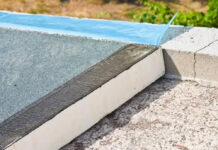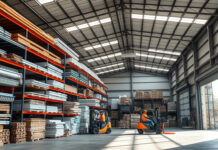When it comes to protecting your property, the roof over your head plays a pivotal role, and beneath the tiles lies a hidden hero: roof underlayment. This critical component may not be visible, but its impact on your home’s durability and safety is immense.
Whether you’re building a new house or maintaining an existing one, investing in high-quality roof underlayment is essential for safeguarding against the elements, and protecting it against water damage and moisture accumulation.
In this article, we’ll explore why roof underlayment is a vital investment for all properties. From its role in moisture protection to its benefits in enhancing roof longevity, understand how this unseen layer provides essential defence and peace of mind.
What is roof underlayment?
The materials available for roofs continue to advance, but roofs are exposed to the UK’s volatile climate, making cracks and gaps common issues for homeowners.
Roof underlayment is a material that goes onto the deck of your roof under the primary materials. It serves as an additional barrier for your roof, protecting it from water and wind damage and reducing the risks of leaks.
Failing to install it means you’re exposing your home to unnecessary risks. There are different types of roof underlayment, with each offering unique benefits.
Synthetic underlayment
Synthetic underlayment uses polypropylene or polyethylene, both durable materials renowned for their resistance to tears. Synthetic roof underlay provides superior UV protection and waterproofing, making it suitable for all climates.
However, while synthetic materials are highly durable, they’re not immune to punctures, and the costs associated with souring them mean many homeowners turn to cost-effective solutions.
Pros:
- Longevity: Synthetic underlayment can last between 25 and 50 years with proper care and maintenance.
- Waterproofing: This underlayment also offers superior waterproofing features, making it ideal for properties that experience heavy rainfall.
- Traction: Synthetic underlayment also has adequate traction, simplifying the installation process.
Cons:
- Expensive: If you want to take advantage of synthetic underlayment, you’ll need to pay big bucks.
- Sustainability: The manufacturing process and materials mean synthetic underlayment isn’t sustainable.
Asphalt-saturated felt
Asphalt-saturated felt is one of the most popular underlayment options because it combines affordability with durability. It also provides excellent protection from the rain, although it’s not as waterproof as synthetic underlayment.
Many people choose roofing felt because it’s tear-resistant and easy to install. While slightly heavier than synthetic underlayment, its affordability and longevity make it an excellent investment.
Pros:
- Affordability: Roofing felt is a cost-effective solution for homes.
- Easy Installation: Its lightweight design means most people can easily install felt underlayment.
- Ventilation: Felt blocks water but allows some moisture to pass through the roof, which enhances ventilation.
Cons:
- Longevity: Roofing felt can last up to 20 years, making it less durable than other options.
- Tearing: It can tear during installation, but most roofers know how to prevent this.
Rubberised asphalt
Rubberised asphalt combines traditional and rubber elements, offering superior waterproofing features and enhanced durability. Aside from its water resistance, rubberised asphalt also has excellent noise-blocking qualities.
Some roofs might not be compatible with this form of asphalt, as it’s typically heavier than synthetic underlayment or traditional roofing felt. It’s also more expensive, so you’ll need a bigger budget.
Pros:
- Usability: Most forms of rubberised asphalt have peel-and-stick functions, making them relatively easy to install.
- Heat Resistance: Rubberised asphalt’s ability to withstand high temperatures is a major benefit, making it beneficial for properties in warm climates.
- Waterproofing: Rubberised asphalt is also highly effective at preventing water from seeping through, and it can form a tight seal around roof joints.
Cons:
- Weight: Unfortunately, rubberised asphalt isn’t lightweight, and some people might struggle to install it alone.
- Costs: Installing rubber asphalt will cost more than other materials. However, it can be worth the investment for homes in areas prone to volatile weather.
Why underlayment is a vital investment
Roofing underlayment sometimes seems inconvenient—until your roof suffers damage and you have to deal with extensive repair costs. Installing it means giving your home additional protection and preventing severe damage.
Let’s take a look at why roofing underlayment is a necessary investment.
Water protection
We all know that the British weather isn’t exactly forgiving, and most homes see a lot of rainfall each year. With climate change continuing to cause intense weather, roof underlayment is essential for preserving your home’s interior and structural integrity.
Even tiny gaps or cracks in your roof can allow water to seep into your property, causing mould growth and damaging your belongings. Failing to notice any damage could also result in structural damage, which leads to extensive repairs.
Installing underlay adds an additional layer of protection to your roof, ensuring it remains impenetrable in heavy rain.
Preserving roofing materials
Most roofing materials are designed to withstand a lot of damage and protect your home, but they can degrade over time. Underlayment can preserve tiles and shingles by working against UV rays, moisture and strong winds.
It also relieves a lot of pressure on the other materials, ensuring a longer-lasting roof with fewer repair needs.
Sustainability
Underlayment can also give your home more thermal protection, ensuring it remains warm and doesn’t lose too much heat through the roof. People in warmer climates can find underlayment that reflects the sun, guaranteeing indoor spaces remain cool.
This means you don’t spend as much money on central heating or air conditioning while also reducing your carbon footprint.
Choosing the right underlayment for your needs
When choosing the right underlayment for your roof, consider whether you need maximum waterproofing or if a combination of affordability and durability better suits your needs.
Most homes in the UK find roofing felt meets their needs, but properties in areas with extreme weather might be better with rubberised asphalt or synthetic materials.
However, older properties might find rubberised asphalt too heavy, which can place excessive weight on the roof, causing structural damage.
Whatever you decide, E-Roofing is your go-to place for cost-effective roofing supplies that serve your needs.
We stock materials from the UK’s most reputable manufacturers, offer speedy delivery times, and are always available to offer advice and support. Please feel free to contact our customer service team, and we’ll get straight back to you.





